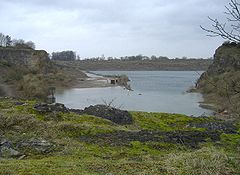| Site of Special Scientific Interest | |
 | |
| Location | Avon |
|---|---|
| Grid reference | ST704916 |
| Interest | Geological |
| Area | 2.7 hectare |
| Notification | 1966 |
| Location map | English Nature |
Slickstones Quarry, Cromhall, also known as Cromhall Quarry, [1] (grid reference ST704916 ) is a 2.7 hectare geological Site of Special Scientific Interest near the village of Cromhall, South Gloucestershire, England notified in 1966.
The quarry is home to South West Maritime Academy, offering both Diving and Open Water Swimming in the 4 hectare quarry lake as well as a broader site use for commercial maritime safety training by the Academy including STCW, STCW Update, marine engineering and deckhand courses as well as various RYA course offerings. [2] The lake can be used by diving trainees as there is a sloping entry (former road) and a pontoon which is also used as an entry point for the swimmers.
The site shows red Triassic rocks from the Magnesian Conglomerate in fissures of older carboniferous limestone from the Friars Point Limestone. [3]
The fossils of two Clevosaurus species, Cryptovaranoides microlanius and Hwiccewyrm trispiculum have been recovered from Slickstones Quarry in 1939 and 1988, 1953, and the 1970s respectively. [4] [1]